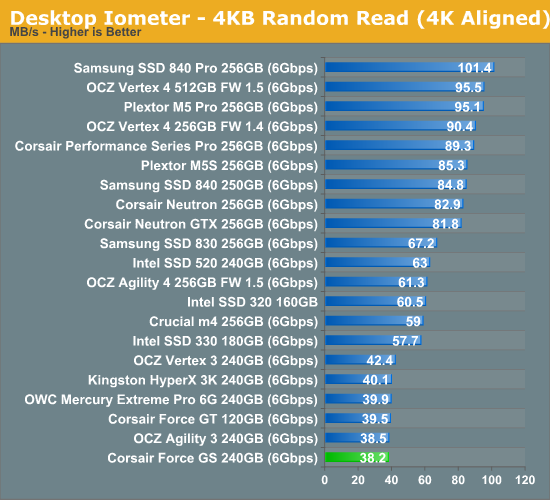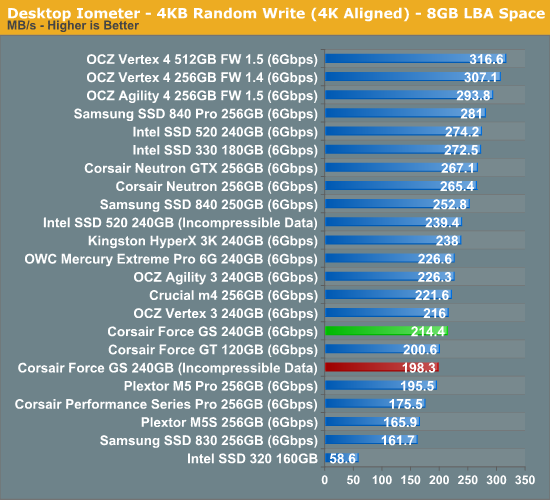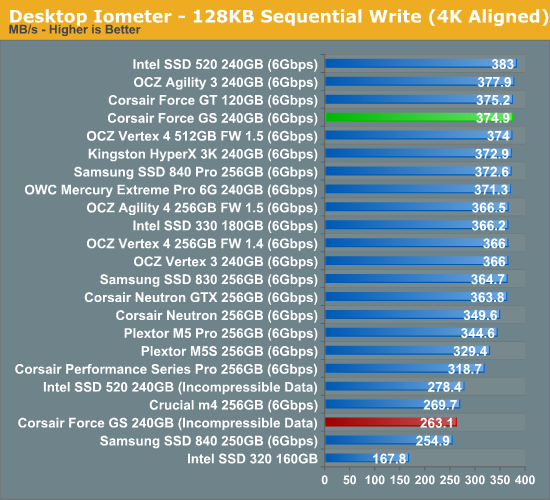SandForce TRIM Issue & Corsair Force Series GS (240GB) Review
by Kristian Vättö on November 22, 2012 1:00 PM ESTRandom Read/Write Speed
The four corners of SSD performance are as follows: random read, random write, sequential read and sequential write speed. Random accesses are generally small in size, while sequential accesses tend to be larger and thus we have the four Iometer tests we use in all of our reviews. Our first test writes 4KB in a completely random pattern over an 8GB space of the drive to simulate the sort of random access that you'd see on an OS drive (even this is more stressful than a normal desktop user would see).
We perform three concurrent IOs and run the test for 3 minutes. The results reported are in average MB/s over the entire time. We use both standard pseudo randomly generated data for each write as well as fully random data to show you both the maximum and minimum performance offered by SandForce based drives in these tests. The average performance of SF drives will likely be somewhere in between the two values for each drive you see in the graphs. For an understanding of why this matters, read our original SandForce article.

Random read speed has never been SandForce's strength and the Force GS is no exception. Real-time compression doesn't provide much benefit to read performance because reading from NAND has always been much faster than programming. Presumably SandForce's third generation controllers (SF-3000) will address random read and write performance, although it's way too early to tell how big of improvements we should expect.


Random write performance is exceptionally low. At queue depth of 3 (the first random write graph), the Force GS manages to stay roughly on-par with other SF-2281 based SSDs, but at queue depth of 32 there is a more noticeable difference. While we are only talking about a difference of a few percents, it's still surprising that the Force GT doesn't achieve speeds similar to other SF-2281 SSDs.
Sequential Read/Write Speed
To measure sequential performance we ran a one minute long 128KB sequential test over the entire span of the drive at a queue depth of 1. The results reported are in average MB/s over the entire test length.


Sequential performance is typical SandForce. With highly compressible data, SandForce SSDs are still the fastest in sequential write speed, although OCZ Vertex 4 is getting very close.










56 Comments
View All Comments
R3dox - Friday, November 23, 2012 - link
I see, but that doesn't really answer my question :P.Is there still a performance hit and do you just choose to test under normal rather than optimal conditions or is this a thing of the past?
Kristian Vättö - Friday, November 23, 2012 - link
I tested this quickly a while back but there was no significant difference in performance (small variation always occurs anyway):http://forums.anandtech.com/showthread.php?t=22721...
R3dox - Friday, November 23, 2012 - link
Thanks for the replies :).You say "AFAIK it affected performance with some older SandForce SSDs but when I started testing SSD and asked Anand for all the settings, he just told me to leave it on since it doesn't matter anymore".
But it's a clear difference on my old postville. Granted, the SSD is my boot disc during those tests, but isn't that their most likely use anyway? TBH I'd be interested to know why enabling those powersaving features apparently impact performance only when used as boot disc. When I say 'impact", I mean based on multiple runs, of course.
Lastly, it seems that C-states are the most impactful setting and that one isn't mentioned in the reviews. I suppose you've left those on as well?
JellyRoll - Wednesday, December 5, 2012 - link
that wasnt testing.Schugy - Tuesday, November 27, 2012 - link
Don/t buy MLC rubbish. SLC is really worth it.FunnyTrace - Wednesday, November 28, 2012 - link
Nice going SandForce.1) BSOD problem
2) AES-256 hardware doesn't work (seriously??? hardware doesn't work???)
3) TRIM has not been working properly (what, you failed to GC blocks properly?)
As a lot of people mention, these SSD makers want to use early adopters and PC building enthusiasts as guinea pigs.